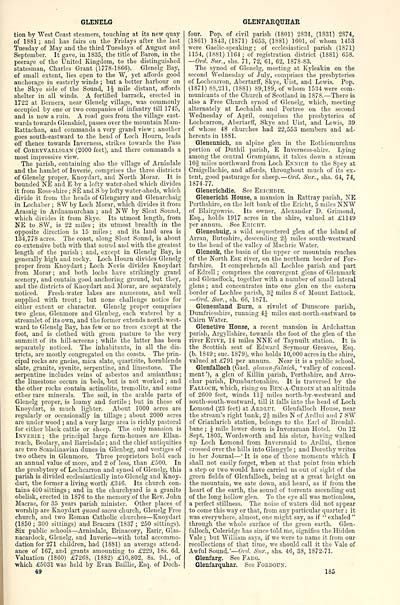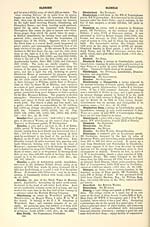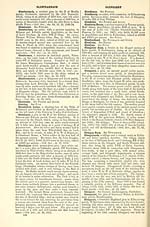Ordnance gazetteer of Scotland > Volume 3
(255) Page 185
Download files
Complete book:
Individual page:
Thumbnail gallery: Grid view | List view

GLENELG
tion by West Coast steamers, touching at its new quay
of 1881 ; and has fairs on tlie Fridays after tlie last
Tuesday of May and the third Tuesdays of August and
September. It gave, in 1835, the title of Baron, in the
peeratre of the United Kingdom, to the distinguished
statesman, Charles Grant (1778-1866). Glenelg Bay,
of small extent, lies open to the W, yet affords good
anchorage in easterly winds ; but a better harbour on
the Skyo side of the Sound, IJ mile distant, affords
shelter in all winds. A fortified barrack, erected in
1722 at Bernera, near Glenelg village, was commonly
occupied by one or two companies of infantry till 1745,
and is now a ruin. A I'oad goes from the village east-
wards towards Glenshiel, passes over the mountain Mam-
Eattachan, and commands a very grand view ; another
goes south-eastward to the head of Loch Hourn, leads
off thence towards Inverness, strikes towards the Pass
of CoKKYVAELiGAN (2000 feet), and there commands a
most impressive view.
The parish, containing also the village of Arnisdale
and the hamlet of Inverie, comprises the three districts
of Glenelg proper, Knoydart, and North Morar. It is
bounded NE and E by a lofty water-shed which divides
it from Ross-shire ; SE and S by lofty water-sheds, which
divide it from the heads of Glengarry and Glenarchaig
in Lochaber ; SW by Loch Morar, which divides it from
Arasaig in Ardnamurchan ; and NW by Sleat Sound,
which divides it from Skye. Its utmost length, from
NE to SW, is 22 miles ; its utmost breadth in the
opposite direction is 15 miles ; and its land area is
134,778 acres. The coast, along Sleat Sound, is about
co-extensive both with that sound and with the greatest
length of the parish ; and, except in Glenelg Bay, is
generally high and rocky. Loch Hourn divides Glenelg
proper from Knoydart ; Loch Nevis divides Knoydart
from Morar ; and both lochs have strikingly grand
scenery, and contain good anchoring ground, but they,
and the districts of Knoydart and Morar, are separately
noticed. Fresh-water lakes are numerous, and well
supplied with trout ; but none challenge notice for
either extent or character. Glenelg proper comprises
two glens, Glenmore and Glenbeg, each watered by a
streamlet of its own, and the former extends north-west-
ward to Glenelg Bay, has few or no trees except at the
foot, and is clothed with green pasture to the very
summit of its hill-screens ; while the latter has been
separately noticed. The inhabitants, in all the dis-
tricts, are mostly congregated on the coasts. The prin-
cipal rocks are gneiss, mica slate, cjuartzite, hornblende
slate, granite, syenite, serpentine, and limestone. The
serpentine includes veins of asbestos and amianthus ;
the limestone occurs in beds, "but is not worked ; and
the other rocks contain actinolite, tremolite, and some
other rare minerals. The soil, in the arable parts of
Glenelg proper, is loamy and fertile ; but in those of
Knoydart, is much lighter. About 1000 acres are
regularly or occasionally in tillage ; about 2000 acres
are under wood ; and a very large area is richly pastoral
for either black cattle or sheep. The only mansion is
Inverie ; the principal large farm-houses are Elian-
reach, Beolary, and Barrisdale ; and the chief antiquities
are two Scandinavian dunes in Glenbeg, and vestiges of
two others in Glenmore. Three proprietors bold each
an annual value of more, and 2 of less, than £500. In
the presbytery of Lochcarron and synod of Glenelg, this
parish is divided ecclesiastically into Glenelg and Knoy-
dart, the former a living worth £346. Its church con-
tains 400 sittings ; and in the churchyard is a granite
obelisk, erected in 1876 to the memory of the Rev. John
Macrae, for 35 years parish minister. Other places of
worship are Knoydart quoad sacra church, Glenelg Free
church, and two Roman Catholic churches — Knoydart
(1850 ; 300 sittings) and Bracara (1837 ; 250 sittings).
Six public schools — Arnisdale, Brinacory, Earir, Glas-
nacardock, Glenelg, and Inverie — with total accommo-
dation for 271 children, had (1881) an average attend-
ance of 167, and grants amounting to £229, 18s. 6d.
Valuation (1860) £7268, (1882) £10,802, 8s. 9d., of
which £5031 was held by Evan Baillie, Esq. of Doch-
€9
GLENFARQTJHAR
four. Pop. of civil parish (1801) 2834, (1831) 2874,
(1861) 1843, (1871) 1653, (1881) 1601, of whom 1453
were Gaelic-speaking; of ecclesiastical parish (1871)
1154, (1881) 1164 ; of registration district (1881) 658.
—Ord. Sur., shs. 71, 72, 61, 62, 1878-83.
The synod of Glenelg, meeting at Kyleakin on the
second Wednesday of July, comprises the presbyteries
of Lochcarron, Abertarff, Skye, Uist, and Lewis. Pop.
(1871) 88,211, (1881) 89,189, of whom 1534 were com-
municants of the Church of Scotland in 1878. — There is
also a Free Church synod of Glenelg, which, meeting
alternately at Lochalsh and Portree on the second
Wednesday of April, comprises the presbyteries of
Lochcarron, Abertarfi', Skye and Uist, and Lewis, 39
of whose 48 churches had 22,553 members and ad-
herents in 1881.
Glenennich, an alpine glen in the Rothiemnrchus
portion of Duthil parish, E Inverness-shire. Lying
among the central Grampians, it takes down a stream
10| miles northward from Loch Ennich to the Spey at
Craigellachie, and affords, throughout much of its ex-
tent, good pasturage for sheep. — Ord. Sur., shs. 64, 74,
1874-77.
Glenerichdie. See EnicHDiE.
Glenericht House, a mansion in Rattray parish, NE
Perthshire, on the left bank of the Ericht, 5 miles NNW
of Blairgowrie. Its owner, Alexander D. Griraond,
Esq., holds 1917 acres in the shire, valued at £1149
per annum. See Ertcht.
Glenesbuig, a wild sequestered glen of the island of
Arran, Buteshire, descending 2J miles south-westward
to the head of the valley of Machrie Water.
Glenesk, the basin of the upper or mountain reaches
of the North EsK river, on the northern border of For-
farshire. It comprehends all Lochlee parish and part
of Edzell ; comprises the convergent glens of Glenmark
and Gleneffock, together with a number of small lateral
glens ; and concentrates into one glen on the eastern
border of Lochlee parish, 3| miles S of Mount Battock.
—Ord. Sur., sh. 66, 1871.
Glenessland Bum, a rivulet of Dunscore parish,
Dumfriesshire, running 4J miles east-north-eastward to
Cairn Water.
Glenetive House, a recent mansion in Ardchattan
parish, Argyllshire, towards the foot of the glen of the
river Etive, 14 miles NNE of Taynuilt station. It is
the Scottish seat of Edward Seymour Greaves, Esq.
(b. 1849; sue. 1879), who holds 10,000 acres in the shire,
valued at £791 per annum. Near it is a public school.
Glenfalloch (Gael, gleann-falaich, ' valley of conceal-
ment '), a glen of Killin parish, Perthshire, and Arro-
char parish, Dumbartonshire. It is traversed by the
Falloch, which, rising on Ben-a-Cheoin at an altitude
of 2600 feet, winds llj miles north-by-westward and
south-south-westward, till it falls into the head of Loch
Lomond (23 feet) at Ardlui. Glenfalloch House, near
the stream's right bank, 2J miles N of Ardlui and 7 SW
of Crianlarich station, belongs to the Earl of Breadal-
bane ; J mile lower down is Inverarnan Hotel. On 12
Sept. 1803, Wordsworth and his sister, having walked
up Loch Lomond from Inversnaid to Ardlui, thence
crossed over the hills into Glengyle ; and Dorothy writes
in her Journal — ' It is one of those moments which I
shall not easily forget, when at that point from which
a step or two would have carried us out of sight of the
green fields of Glenfalloch, being at a great height on
the mountain, we sate down, and heard, as if from the
heart of the earth, the sound of torrents ascending out
of the long hollow glen. To the eye all was motionless,
a perfect stillness. The noise of waters did not appear
to come this way or that, from any particular quarter : it
was everywhere, almost, one might say, as if "exhaled"
through the whole surface of the green earth. Glen-
falloch, Coleridge has since told me, signifies the Hidden
Vale ; hut William says, if we were to name it from our
recollections of that time, we should call it the Vale of
Awful Sound. '—0?-d. Sur., shs. 46, 38, 1872-71.
Glenfarg. See Faeg.
Glenfarquhar. See Foedoun.
185
tion by West Coast steamers, touching at its new quay
of 1881 ; and has fairs on tlie Fridays after tlie last
Tuesday of May and the third Tuesdays of August and
September. It gave, in 1835, the title of Baron, in the
peeratre of the United Kingdom, to the distinguished
statesman, Charles Grant (1778-1866). Glenelg Bay,
of small extent, lies open to the W, yet affords good
anchorage in easterly winds ; but a better harbour on
the Skyo side of the Sound, IJ mile distant, affords
shelter in all winds. A fortified barrack, erected in
1722 at Bernera, near Glenelg village, was commonly
occupied by one or two companies of infantry till 1745,
and is now a ruin. A I'oad goes from the village east-
wards towards Glenshiel, passes over the mountain Mam-
Eattachan, and commands a very grand view ; another
goes south-eastward to the head of Loch Hourn, leads
off thence towards Inverness, strikes towards the Pass
of CoKKYVAELiGAN (2000 feet), and there commands a
most impressive view.
The parish, containing also the village of Arnisdale
and the hamlet of Inverie, comprises the three districts
of Glenelg proper, Knoydart, and North Morar. It is
bounded NE and E by a lofty water-shed which divides
it from Ross-shire ; SE and S by lofty water-sheds, which
divide it from the heads of Glengarry and Glenarchaig
in Lochaber ; SW by Loch Morar, which divides it from
Arasaig in Ardnamurchan ; and NW by Sleat Sound,
which divides it from Skye. Its utmost length, from
NE to SW, is 22 miles ; its utmost breadth in the
opposite direction is 15 miles ; and its land area is
134,778 acres. The coast, along Sleat Sound, is about
co-extensive both with that sound and with the greatest
length of the parish ; and, except in Glenelg Bay, is
generally high and rocky. Loch Hourn divides Glenelg
proper from Knoydart ; Loch Nevis divides Knoydart
from Morar ; and both lochs have strikingly grand
scenery, and contain good anchoring ground, but they,
and the districts of Knoydart and Morar, are separately
noticed. Fresh-water lakes are numerous, and well
supplied with trout ; but none challenge notice for
either extent or character. Glenelg proper comprises
two glens, Glenmore and Glenbeg, each watered by a
streamlet of its own, and the former extends north-west-
ward to Glenelg Bay, has few or no trees except at the
foot, and is clothed with green pasture to the very
summit of its hill-screens ; while the latter has been
separately noticed. The inhabitants, in all the dis-
tricts, are mostly congregated on the coasts. The prin-
cipal rocks are gneiss, mica slate, cjuartzite, hornblende
slate, granite, syenite, serpentine, and limestone. The
serpentine includes veins of asbestos and amianthus ;
the limestone occurs in beds, "but is not worked ; and
the other rocks contain actinolite, tremolite, and some
other rare minerals. The soil, in the arable parts of
Glenelg proper, is loamy and fertile ; but in those of
Knoydart, is much lighter. About 1000 acres are
regularly or occasionally in tillage ; about 2000 acres
are under wood ; and a very large area is richly pastoral
for either black cattle or sheep. The only mansion is
Inverie ; the principal large farm-houses are Elian-
reach, Beolary, and Barrisdale ; and the chief antiquities
are two Scandinavian dunes in Glenbeg, and vestiges of
two others in Glenmore. Three proprietors bold each
an annual value of more, and 2 of less, than £500. In
the presbytery of Lochcarron and synod of Glenelg, this
parish is divided ecclesiastically into Glenelg and Knoy-
dart, the former a living worth £346. Its church con-
tains 400 sittings ; and in the churchyard is a granite
obelisk, erected in 1876 to the memory of the Rev. John
Macrae, for 35 years parish minister. Other places of
worship are Knoydart quoad sacra church, Glenelg Free
church, and two Roman Catholic churches — Knoydart
(1850 ; 300 sittings) and Bracara (1837 ; 250 sittings).
Six public schools — Arnisdale, Brinacory, Earir, Glas-
nacardock, Glenelg, and Inverie — with total accommo-
dation for 271 children, had (1881) an average attend-
ance of 167, and grants amounting to £229, 18s. 6d.
Valuation (1860) £7268, (1882) £10,802, 8s. 9d., of
which £5031 was held by Evan Baillie, Esq. of Doch-
€9
GLENFARQTJHAR
four. Pop. of civil parish (1801) 2834, (1831) 2874,
(1861) 1843, (1871) 1653, (1881) 1601, of whom 1453
were Gaelic-speaking; of ecclesiastical parish (1871)
1154, (1881) 1164 ; of registration district (1881) 658.
—Ord. Sur., shs. 71, 72, 61, 62, 1878-83.
The synod of Glenelg, meeting at Kyleakin on the
second Wednesday of July, comprises the presbyteries
of Lochcarron, Abertarff, Skye, Uist, and Lewis. Pop.
(1871) 88,211, (1881) 89,189, of whom 1534 were com-
municants of the Church of Scotland in 1878. — There is
also a Free Church synod of Glenelg, which, meeting
alternately at Lochalsh and Portree on the second
Wednesday of April, comprises the presbyteries of
Lochcarron, Abertarfi', Skye and Uist, and Lewis, 39
of whose 48 churches had 22,553 members and ad-
herents in 1881.
Glenennich, an alpine glen in the Rothiemnrchus
portion of Duthil parish, E Inverness-shire. Lying
among the central Grampians, it takes down a stream
10| miles northward from Loch Ennich to the Spey at
Craigellachie, and affords, throughout much of its ex-
tent, good pasturage for sheep. — Ord. Sur., shs. 64, 74,
1874-77.
Glenerichdie. See EnicHDiE.
Glenericht House, a mansion in Rattray parish, NE
Perthshire, on the left bank of the Ericht, 5 miles NNW
of Blairgowrie. Its owner, Alexander D. Griraond,
Esq., holds 1917 acres in the shire, valued at £1149
per annum. See Ertcht.
Glenesbuig, a wild sequestered glen of the island of
Arran, Buteshire, descending 2J miles south-westward
to the head of the valley of Machrie Water.
Glenesk, the basin of the upper or mountain reaches
of the North EsK river, on the northern border of For-
farshire. It comprehends all Lochlee parish and part
of Edzell ; comprises the convergent glens of Glenmark
and Gleneffock, together with a number of small lateral
glens ; and concentrates into one glen on the eastern
border of Lochlee parish, 3| miles S of Mount Battock.
—Ord. Sur., sh. 66, 1871.
Glenessland Bum, a rivulet of Dunscore parish,
Dumfriesshire, running 4J miles east-north-eastward to
Cairn Water.
Glenetive House, a recent mansion in Ardchattan
parish, Argyllshire, towards the foot of the glen of the
river Etive, 14 miles NNE of Taynuilt station. It is
the Scottish seat of Edward Seymour Greaves, Esq.
(b. 1849; sue. 1879), who holds 10,000 acres in the shire,
valued at £791 per annum. Near it is a public school.
Glenfalloch (Gael, gleann-falaich, ' valley of conceal-
ment '), a glen of Killin parish, Perthshire, and Arro-
char parish, Dumbartonshire. It is traversed by the
Falloch, which, rising on Ben-a-Cheoin at an altitude
of 2600 feet, winds llj miles north-by-westward and
south-south-westward, till it falls into the head of Loch
Lomond (23 feet) at Ardlui. Glenfalloch House, near
the stream's right bank, 2J miles N of Ardlui and 7 SW
of Crianlarich station, belongs to the Earl of Breadal-
bane ; J mile lower down is Inverarnan Hotel. On 12
Sept. 1803, Wordsworth and his sister, having walked
up Loch Lomond from Inversnaid to Ardlui, thence
crossed over the hills into Glengyle ; and Dorothy writes
in her Journal — ' It is one of those moments which I
shall not easily forget, when at that point from which
a step or two would have carried us out of sight of the
green fields of Glenfalloch, being at a great height on
the mountain, we sate down, and heard, as if from the
heart of the earth, the sound of torrents ascending out
of the long hollow glen. To the eye all was motionless,
a perfect stillness. The noise of waters did not appear
to come this way or that, from any particular quarter : it
was everywhere, almost, one might say, as if "exhaled"
through the whole surface of the green earth. Glen-
falloch, Coleridge has since told me, signifies the Hidden
Vale ; hut William says, if we were to name it from our
recollections of that time, we should call it the Vale of
Awful Sound. '—0?-d. Sur., shs. 46, 38, 1872-71.
Glenfarg. See Faeg.
Glenfarquhar. See Foedoun.
185
Set display mode to: Large image | Transcription
Images and transcriptions on this page, including medium image downloads, may be used under the Creative Commons Attribution 4.0 International Licence unless otherwise stated. ![]()
| Gazetteers of Scotland, 1803-1901 > Ordnance gazetteer of Scotland > Volume 3 > (255) Page 185 |
|---|
| Permanent URL | https://digital.nls.uk/97379514 |
|---|
| Attribution and copyright: |
|
|---|---|

